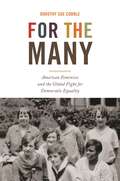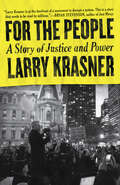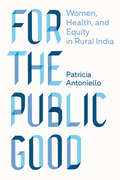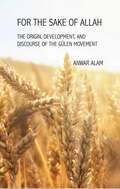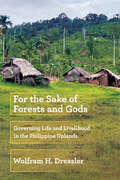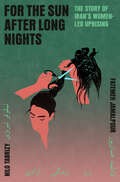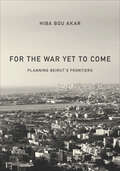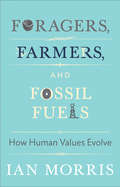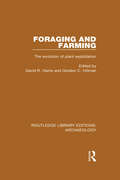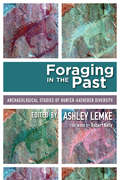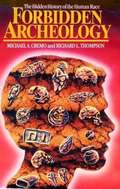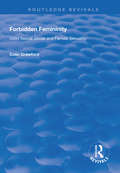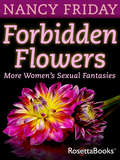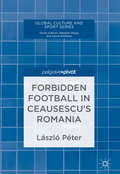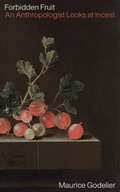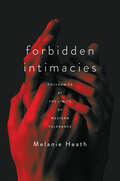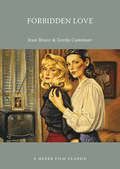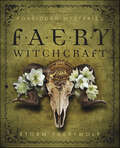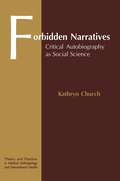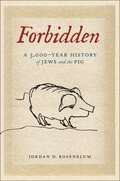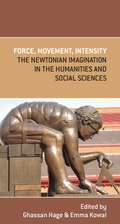- Table View
- List View
For the Many: American Feminists and the Global Fight for Democratic Equality (America in the World #56)
by Dorothy Sue CobbleA history of the twentieth-century feminists who fought for the rights of women, workers, and the poor, both in the United States and abroadFor the Many presents an inspiring look at how US women and their global allies pushed the nation and the world toward justice and greater equality for all. Reclaiming social democracy as one of the central threads of American feminism, Dorothy Sue Cobble offers a bold rewriting of twentieth-century feminist history and documents how forces, peoples, and ideas worldwide shaped American politics. Cobble follows egalitarian women’s activism from the explosion of democracy movements before World War I to the establishment of the New Deal, through the upheavals in rights and social citizenship at midcentury, to the reassertion of conservatism and the revival of female-led movements today.Cobble brings to life the women who crossed borders of class, race, and nation to build grassroots campaigns, found international institutions, and enact policies dedicated to raising standards of life for everyone. Readers encounter famous figures, including Eleanor Roosevelt, Frances Perkins, and Mary McLeod Bethune, together with less well-known leaders, such as Rose Schneiderman, Maida Springer Kemp, and Esther Peterson. Multiple generations partnered to expand social and economic rights, and despite setbacks, the fight for the many persists, as twenty-first-century activists urgently demand a more caring, inclusive world.Putting women at the center of US political history, For the Many reveals the powerful currents of democratic equality that spurred American feminists to seek a better life for all.
For the People
by Ronald P. FormisanoFor the People offers a new interpretation of populist political movements from the Revolution to the eve of the Civil War and roots them in the disconnect between the theory of rule by the people and the reality of rule by elected representatives. Ron Formisano seeks to rescue populist movements from the distortions of contemporary opponents as well as the misunderstandings of later historians.From the Anti-Federalists to the Know-Nothings, Formisano traces the movements chronologically, contextualizing them and demonstrating the progression of ideas and movements. Although American populist movements have typically been categorized as either progressive or reactionary, left-leaning or right-leaning, Formisano argues that most populist movements exhibit liberal and illiberal tendencies simultaneously. Gendered notions of "manhood" are an enduring feature, yet women have been intimately involved in nearly every populist insurgency. By considering these movements together, Formisano identifies commonalities that belie the pattern of historical polarization and bring populist movements from the margins to the core of American history.
For the People: A Story of Justice and Power
by Larry KrasnerPhiladelphia&’s progressive district attorney offers an inspiring vision of how people can take back power to reform criminal justice, based on lessons from a life&’s work as an advocate for the accused.&“Larry Krasner is at the forefront of a movement to disrupt a system. This is a story that needs to be read by millions.&”—Bryan Stevenson, author of Just MercyLarry Krasner spent thirty years learning about America&’s carceral system as a civil rights and criminal defense lawyer in Philadelphia, working to get some kind of justice for his clients in a broken system, before deciding that the way to truly transform the system was to get inside of it. So he launched an unlikely campaign to become the district attorney of Philadelphia, a city known for its long line of notorious &“tough on crime&” DAs who had turned Philly into a city with one of the highest rates of incarceration in the country. Despite long odds and derisive opposition from the police union and other forces of the status quo, Krasner laid out a simple case for radical reform and won the November general election by a margin of nearly 50 percent.For the People is not just a story about Krasner&’s remarkable early life as a defense lawyer and his powerful, grassroots campaign; it&’s also a larger exploration of how power and injustice conspired to create a carceral state unprecedented in the world. Readers follow Krasner&’s lifelong journey through the streets and courtrooms and election precincts of one American city all the way up to his swearing-in ceremony to see how our system of injustice was built—and how we might dismantle it.In the tradition of powerful critiques of the criminal justice system, from Bryan Stevenson&’s Just Mercy to Michelle Alexander&’s The New Jim Crow, For the People makes the powerful case that transforming criminal justice is the most important civil rights movement of our time and can only be done if we&’re willing to fight for the power to make a change.
For the Public Good: Women, Health, and Equity in Rural India (Policy to Practice)
by Patricia AntonielloFor the Public Good details the role of the Comprehensive Rural Health Project (CRHP), a groundbreaking, internationally recognized primary health care model that uses local solutions to solve intractable global health problems. Emphasizing equity and community participation, this grassroots approach recruits local women to be educated as village-based health workers. In turn, women village health workers collaborate to overcome the dominant double prejudices in local villages—caste and gender inequality. In one generation, village health workers have progressed from child brides and sequestered wives to knowledgeable health practitioners, valued teachers, and community leaders. Through collective efforts, CRHP has reduced infant and maternal mortality, eliminated some endemic health problems, and advanced economic well-being in villages with women's cooperative lending groups. This book describes how the recognition and elimination of embedded inequalities—in this case caste discrimination, gender subordination, and class injustice—promote health and well-being and collaboratively establish the public good.
For the Sake of Allah: The Origin, Development and Discourse of The Gulen Movement
by Anwar AlamFor the Sake of Allah explores the Gülen Movement, also known as Hizmet, a religio-social movement inspired by Fethullah Gülen, one of the most prominent Islamic scholars of Turkish origin in the modern world. Notwithstanding the current purge of Hizmet under the Erdoğan regime, it is one of the most interesting faith-based movements to arise from a Muslim society in the twentieth century. Since the late 1960s, Hizmet has opened thousands of schools around the world and has also contributed to relief efforts in Turkey and abroad.In this book, Anwar Alam shares a decade of research and field work based on the religious, educational, political, and social contexts that have shaped the essential dynamics of both Gülen and the Movement. At a time when the Gülen Movement has been primarily analyzed and debated through the &“state prism&” and &“security discourse,&” especially following the failed Turkish military coup of July 2016, this book takes a longue durée perspective and provides a holistic treatment of Hizmet as essentially a postmodern phenomenon.
For the Sake of Forests and Gods: Governing Life and Livelihood in the Philippine Uplands
by Wolfram H. DresslerFor the Sake of Forests and Gods documents the consequences of nonstate actors impinging on the existence of Indigenous peoples in the remote highlands of Palawan Island, the Philippines. Nimble, focused, and well-funded, religious and environmental organizations increasingly assume governmental authority over the lives and livelihoods of the Pala'wan people within their ancestral territories.Wolfram H. Dressler traces these actors' history and contemporary practices, revealing how they bypass the state to govern the less governed. In the highlands, environmental NGOs valorize customary objects and practices to suppress swidden and support forest conservation, while evangelical missionaries regulate Pala'wan beliefs, health, and hygiene.Bridging material studies and biopolitics, For the Sake of Forests and Gods explores how these nonstate actors use customary objects for comprehensive reforms of Pala'wan bodies and souls, centering on how the unique properties of the Tingkep basket mediate nonstate biopower. These reforms impact highlanders differently: some adopt biopolitical ideals willingly, others for political and economic gain. Yet others resist interventions, prioritizing family livelihoods. Ultimately, Dressler argues that Indigenous sovereignty matters more than ever as nonstate biopower intensifies in Southeast Asia's uplands.
For the Sun After Long Nights: The Story of Iran's Women-Led Uprising
by Fatemeh Jamalpour Nilo TabrizyLONGLISTED FOR THE NATIONAL BOOK AWARD • A moving exploration of the 2022 women-led protests in Iran, as told through the interwoven stories of two Iranian journalists &“Unlike anything I&’ve read . . . A searing, courageous, and ultimately beautiful book filled with the spirit of the movement that it covers.&” —Ben Rhodes, author of The World as It Is: A Memoir of the Obama White HouseIn September 2022, a young Kurdish woman, Mahsa Jîna Amini, died after being beaten by police officers who arrested her for not adhering to the Islamic Republic&’s dress code. Her death galvanized thousands of Iranians—mostly women—who took to the streets in one of the country&’s largest uprisings in decades: the Woman, Life, Freedom movement.Despite the threat of imprisonment or death for her work as a journalist covering political unrest, state repression, and grassroots activism in Iran—which has led to multiple interrogation sessions and arrests—Fatemeh Jamalpour joined the throngs of people fighting to topple Iran&’s religious extremist regime. And across the globe, Nilo Tabrizy, who emigrated from Iran with her family as a child, covered the protests and state violence, knowing that spotlighting the women on the front lines and the systemic injustice of the Iranian government meant she would not be able to safely return to Iran in the future.Though they had met only once in person, Nilo and Fatemeh corresponded constantly, often through encrypted platforms to protect Fatemeh. As the protests continued to unfold, the sense of sisterhood they shared led them to embark on an effort to document the spirit and legacy of the movement, and the history, geopolitics, and influences that led to this point. At once deeply personal and assiduously reported, For the Sun After Long Nights offers two perspectives on what it means to cover the stories that are closest to one&’s heart—both in the forefront and from afar.
For the War Yet to Come: Planning Beirut's Frontiers
by Hiba Bou AkarBeirut is a city divided. Following the Green Line of the civil war, dividing the Christian east and the Muslim west, today hundreds of such lines dissect the city. For the residents of Beirut, urban planning could hold promise: a new spatial order could bring a peaceful future. But with unclear state structures and outsourced public processes, urban planning has instead become a contest between religious-political organizations and profit-seeking developers. Neighborhoods reproduce poverty, displacement, and urban violence. For the War Yet to Come examines urban planning in three neighborhoods of Beirut's southeastern peripheries, revealing how these areas have been developed into frontiers of a continuing sectarian order. Hiba Bou Akar argues these neighborhoods are arranged, not in the expectation of a bright future, but according to the logic of "the war yet to come": urban planning plays on fears and differences, rumors of war, and paramilitary strategies to organize everyday life. As she shows, war in times of peace is not fought with tanks, artillery, and rifles, but involves a more mundane territorial contest for land and apartment sales, zoning and planning regulations, and infrastructure projects.
Foragers, Farmers, and Fossil Fuels: How Human Values Evolve
by Margaret Atwood Jonathan D. Spence Stephen Macedo Christine M. Korsgaard Ian Morris Richard SeafordMost people in the world today think democracy and gender equality are good, and that violence and wealth inequality are bad. But most people who lived during the 10,000 years before the nineteenth century thought just the opposite. Drawing on archaeology, anthropology, biology, and history, Ian Morris, author of the best-selling Why the West Rules--for Now, explains why. The result is a compelling new argument about the evolution of human values, one that has far-reaching implications for how we understand the past--and for what might happen next.Fundamental long-term changes in values, Morris argues, are driven by the most basic force of all: energy. Humans have found three main ways to get the energy they need--from foraging, farming, and fossil fuels. Each energy source sets strict limits on what kinds of societies can succeed, and each kind of society rewards specific values. In tiny forager bands, people who value equality but are ready to settle problems violently do better than those who aren't; in large farming societies, people who value hierarchy and are less willing to use violence do best; and in huge fossil-fuel societies, the pendulum has swung back toward equality but even further away from violence.But if our fossil-fuel world favors democratic, open societies, the ongoing revolution in energy capture means that our most cherished values are very likely to turn out--at some point fairly soon--not to be useful any more.Originating as the Tanner Lectures delivered at Princeton University, the book includes challenging responses by novelist Margaret Atwood, philosopher Christine Korsgaard, classicist Richard Seaford, and historian of China Jonathan Spence.
Foraging and Farming: The Evolution of Plant Exploitation (Routledge Library Editions: Archaeology #Vol. 13)
by David R. Harris and Gordon C. HillmanThis book is one of a series of more than 20 volumes resulting from the World Archaeological Congress, September 1986, attempting to bring together not only archaeologists and anthropologists from many parts of the world, as well as academics from contingent disciplines, but also non-academics from a wide range of cultural backgrounds. This volume develops a new approach to plant exploitation and early agriculture in a worldwide comparative context. It modifies the conceptual dichotomy between "hunter-gatherers" and "farmers", viewing human exploitation of plant resources as a global evolutionary process which incorporated the beginnings of cultivation and crop domestication. The studies throughout the book come from a worldwide range of geographical contexts, from the Andes to China and from Australia to the Upper Mid-West of North America. This work is of interest to anthropologists, archaeologists, botanists and geographers. Originally published 1989.
Foraging in the Past: Archaeological Studies of Hunter-Gatherer Diversity
by LemkeThe label “hunter-gatherer” covers an extremely diverse range of societies and behaviors, yet most of what is known is provided by ethnographic and historical data that cannot be used to interpret prehistory. Foraging in the Past takes an explicitly archaeological approach to the potential of the archaeological record to document the variability and time depth of hunter-gatherers. Well-established and young scholars present new prehistoric data and describe new methods and theories to investigate ancient forager lifeways and document hunter-gatherer variability across the globe. The authors use relationships established by cross-cultural data as a background for examining the empirical patterns of prehistory. Covering underwater sites in North America, the peaks of the Andes, Asian rainforests, and beyond, chapters are data rich, methodologically sound, and theoretically nuanced, effectively exploring the latest evidence for behavioral diversity in the fundamental process of hunting and gathering. Foraging in the Past establishes how hunter-gatherers can be considered archaeologically, extending beyond the reach of ethnographers and historians to argue that only through archaeological research can the full range of hunter-gatherer variability be documented. Presenting a comprehensive and integrated approach to forager diversity in the past, the volume will be of significance to both students and scholars working with or teaching about hunter-gatherers. Contributors: Nicholas J. Conard, Raven Garvey, Keiko Kitagawa, John Krigbaum, Petra Krönneck, Steven Kuhn, Julia Lee-Thorp, Peter Mitchell, Katherine Moore, Susanne C. Münzel, Kurt Rademaker, Patrick Roberts, Britt Starkovich, Brian A. Stewart, Mary Stiner
Forbidden Archeology
by Michael A. Cremo Richard L. ThompsonThe hidden history of the human race, a remarkably complete review of the scientific evidence concerning human origins.
Forbidden Bookshelf Presents Dan E. Moldea: Interference, The Hoffa Wars, and Dark Victory (Forbidden Bookshelf)
by Dan E. MoldeaThree exposés of corruption—behind the NFL, the Teamsters and Jimmy Hoffa, and Ronald Reagan—from an investigative reporter who &“never relents&” (The Washington Post). Interference: A shocking exposé of widespread corruption and mob influence throughout the National Football League—on the field, in the owners&’ boxes, and in the corporate suites. &“[A] true and terrifying picture of a business whose movers and shakers seem to have more connections to gambling and the mob than to touchdowns and Super Bowls.&” —Keith Olbermann The Hoffa Wars: The definitive portrait of the powerful, corruption-ridden Teamsters union and its legendary president, Jimmy Hoffa—organizer, gangster, convict, and conspirator—whose disappearance in 1975 remains one of the great unsolved mysteries. &“Mr. Moldea&’s view of [the Hoffa] wars, which reached its greatest intensity when Robert Kennedy was Attorney General, may explain not only Mr. Hoffa&’s disappearance, but the assassination of John Kennedy as well.&” —The Wall Street Journal Dark Victory: A &“smoldering indictment&” of the corrupt influences that rescued Ronald Reagan&’s acting career, made him millions (resulting in a federal grand jury hearing), backed his political career, and shaped his presidency (Library Journal). &“[Moldea] has, through sheer tenacity, amassed an avalanche of ominous and unnerving facts. [Dark Victory is] a book about power, ego, and the American way.&” —Los Angeles Times
Forbidden Femininity: Child Sexual Abuse and Female Sexuality (Routledge Revivals)
by Colin CrawfordFirst Published in 1997, Crawford attempts to contextualise ideas of female sexuality as signified in academic, popular and in literary publications. Exploring themes of maternal sexuality, the suppression of female sexuality , clinical case studies and the reality of female sexuality in regards to Freudian and other literature.
Forbidden Flowers: More Women's Sexual Fantasies
by Nancy FridayA collection of women&’s intimate erotic thoughts by the #1 New York Times–bestselling author of The Secret Garden and &“liberator of the female libido&” (Newsday). The publication of the groundbreaking expose on women's sexual fantasies, My Secret Garden, ushered in a revolution in women's sexual freedom of expression. In Forbidden Flowers, Nancy Friday reveals even more erotic, wild, and explicit fantasies expressed by women all over the world, from all ethnic and socioeconomic backgrounds. Like My Secret Garden before it, Forbidden Flowers is a celebration of the depth, potency, and imaginative breadth of women&’s inner erotic lives. By giving female readers a glimpse into the ordinary and often extraordinary fantasies of other women, it offers to some an exhilarating freedom from the guilt and shame so often associated with sexual fantasy—and to others, provides fascinating insight into the psychology of female sexual response. &“The author whose books about gender politics helped redefine American women&’s sexuality.&” —The New York Times
Forbidden Football in Ceausescu’s Romania
by László PéterThis book presents an ethnographic description and sociological interpretation of the ‘football gatherings’ that evolved out of central Romania in the late twentieth century. In the 1980's, Romanian public television did not broadcast football mega-events for economic and political reasons. In response, masses of people would leave their homes and travel into the mountains to pick-up the TV broadcast from neighbouring countries. The phenomenon grew into a social institution with a penetrating force: it produced an alternative social space and a dissident public that pointed to a form of resistance taking place through football.Forbidden Football in Ceausescu’s Romania provides an insight into the everyday life under the pressure of dictatorship and, through the special patterns of sports consumption, it tells a social history through small individual stories related to football.
Forbidden Fruit: An Anthropologist Looks at Incest
by Maurice GodelierExploring the role of the incest prohibition in human societiesWhat is incest? Is it universally prohibited? Does this prohibition concern only "biological" kinships or does it extend to various "social" kinships, such as those that are formed today in so-called blended families but which also exist in many other societies?This prohibition plays a fundamental role in the functioning of the multiple kinship systems studied throughout the world. But where does it come from? Can we think, with Claude Lévi-Strauss, that the prohibition of incest alone marks the passage from nature to culture? And how can we understand, then, the persistent tension between the proclaimed, institutionalized prohibition and the incestuous practice which, everywhere, remains?World-renowned anthropologist Maurice Godelier highlights an essential fact, the spontaneously asocial and undifferentiated character of human sexuality and the need for a social regulation of this spontaneity. It thus brings to light the main teachings of anthropology on the question of incest, a major social fact of burning relevance today.
Forbidden Intimacies: Polygamies at the Limits of Western Tolerance (Globalization in Everyday Life)
by Melanie HeathA poignant account of everyday polygamy and what its regulation reveals about who is viewed as an "Other" In the past thirty years, polygamy has become a flashpoint of conflict as Western governments attempt to regulate certain cultural and religious practices that challenge seemingly central principles of family and justice. In Forbidden Intimacies, Melanie Heath comparatively investigates the regulation of polygamy in the United States, Canada, France, and Mayotte. Drawing on a wealth of ethnographic and archival sources, Heath uncovers the ways in which intimacies framed as "other" and "offensive" serve to define the very limits of Western tolerance. These regulation efforts, counterintuitively, allow the flourishing of polygamies on the ground. The case studies illustrate a continuum of justice, in which some groups, like white fundamentalist Mormons in the U.S., organize to fight against the prohibition of their families' existence, whereas African migrants in France face racialized discrimination in addition to rigid migration policies. The matrix of legal and social contexts, informed by gender, race, sexuality, and class, shapes the everyday experiences of these relationships. Heath uses the term "labyrinthine love" to conceptualize the complex ways individuals negotiate different kinds of relationships, ranging from romantic to coercive. What unites these families is the secrecy in which they must operate. As government intervention erodes their abilities to secure housing, welfare, work, and even protection from abuse, Heath exposes the huge variety of intimacies, and the power they hold to challenge heteronormative, Western ideals of love.
Forbidden Love: A Queer Film Classic
by Gerda Cammaer Jean BruceA Queer Film Classic on the 1992 feature documentary on lesbian experience from the 1940s to the 1960s as seen through the lens of lesbian pulp fiction. This award-winning movie became the most popular ever produced by the National Film Board of Canada, and became emblematic of the bold new queer cinema of the early 1990s. In 2014, the NFB re-released the film in a digitally remastered version.Jean Bruce and Gerda Cammaer are both associate professors in the School of Image Arts at Ryerson University in Toronto.
Forbidden Mysteries of Faery Witchcraft
by Storm Faerywolf&“Far from a dry primer, this book is a poetic dance through the most powerful work of Witchcraft leaving the reader ready to inhale the art of Magick.&” ―Courtney Weber, author of Hekate Whether your demons are ancient spirits or demons of your own making, you must confront them in order to reclaim the power they have stolen. Guiding you through enchantments, demonic rituals, divine possession, necromancy, and occultus maleficum, this book helps you cultivate and explore your forsaken shadows. When you peer behind the veil of comfort and face your most powerful fears, you can truly begin to refine and strengthen your own magical will. In Forbidden Mysteries of Faery Witchcraft, you will learn how to: Summon primal underworld goddesses of the elemental powers Walk the bone road and help trapped spirits cross over Become a worthy vessel for divine possession Perform as an oracle, speaking the wisdom of the gods on earth Cast and break curses, the dark art of offensive magic The powerful techniques of the Faery Tradition of Witchcraft await. Through these rituals, you will glimpse the secret inner workings of nature herself and open the doorway to unimagined sources of energy.&“Take that step of abandonment into these forbidden mysteries, and you will not regret it.&” ―R. J. Stewart, author of Power Within the Land&“What strikes me about Storm Faerywolf&’s work in the Craft is that it is highly innovative, yet still stands firmly in the Feri tradition. This book continues his personal work of holding tension between innovation and tradition.&” ―Anaar, Grandmaster of the Feri tradition and archivist for the Victor & Cora Anderson Archive
Forbidden Narratives: Critical Autobiography as Social Science (Theory And Practice In Medical Anthropology And International Health Ser. #Vol. 2)
by Kathryn ChurchForbidden Narratives: Critical Autobiography as Social Science explores overlapping layers of voices and stories that convey the social relations of psychiatric survivor participation within a community mental health service system. It is written from the perspective of a woman who, in the course of working with the survivor movement, had a physical and emotional breakdown. Ironically, the author found herself personally confronted with issues she typically dealt with only from a distance: as a mental health professional, a researcher, and an activist.The author of this volume writes herself into her work as a major character. Narratives such as this have traditionally been forbidden as outside proper professional standards. Now they are claiming and receiving attention. Forbidden Narratives has the power to speak to a broad audience not only of mental health professionals but also policy makers, sociologists and feminists. It is about the breaking up of professional discourse. It demonstrates and signals profound changes in the social sciences.
Forbidden Sex, Forbidden Texts: New India's Gay Poets
by Hoshang MerchantThe book argues that there is no monolithic homosexuality; there are only homosexualities, that is, there are as many reasons for being gay as there are gays. Some people are born gay, some have gayness thrust upon them, and some do, indeed, achieve to great gayness. Representation of homosexuality/homoeroticism, as it is understood today, is thus a western import. The act and public/social discourses on same-sex love are still illegal; it is, according to many, against the Indian ‘tradition’; and a sense of ‘history’ is seriously problematic when we dig out for a past tradition of homoerotic love and desire. Hoshang Merchant, through an examination of texts, films, poetry, attempts to analyse and crack the codes of sexual (mis)conduct in contemporary India, giving short histories of the fate of several gay writers and explaining the difficulties of ‘coming out’.
Forbidden: A 3,000-Year History of Jews and the Pig
by Jordan D. RosenblumWinner of the 74th National Jewish Book Award: The Jane and Stuart Weitzman Family Award for Food Writing and CookbooksA surprising history of how the pig has influenced Jewish identityJews do not eat pig. This (not always true) observation has been made by both Jews and non-Jews for more than three thousand years and is rooted in biblical law. Though the Torah prohibits eating pig meat, it is not singled out more than other food prohibitions. Horses, rabbits, squirrels, and even vultures, while also not kosher, do not inspire the same level of revulsion for Jews as the pig. The pig has become an iconic symbol for people to signal their Jewishness, non-Jewishness, or rebellion from Judaism. There is nothing in the Bible that suggests Jews are meant to embrace this level of pig-phobia.Starting with the Hebrew Bible, Jordan D. Rosenblum historicizes the emergence of the pig as a key symbol of Jewish identity, from the Roman persecution of ancient rabbis, to the Spanish Inquisition, when so-called Marranos (“Pigs”) converted to Catholicism, to Shakespeare’s writings, to modern memoirs of those leaving Orthodox Judaism. The pig appears in debates about Jewish emancipation in eighteenth-century England and in vaccine conspiracies; in World War II rallying cries, when many American Jewish soldiers were “eating ham for Uncle Sam;” in conversations about pig sandwiches reportedly consumed by Karl Marx; and in recent deliberations about the kosher status of Impossible Pork.All told, there is a rich and varied story about the associations of Jews and pigs over time, both emerging from within Judaism and imposed on Jews by others. Expansive yet accessible, Forbidden offers a captivating look into Jewish history and identity through the lens of the pig.
Force and Freedom: Black Abolitionists and the Politics of Violence (America in the Nineteenth Century)
by Kellie Carter JacksonFrom its origins in the 1750s, the white-led American abolitionist movement adhered to principles of "moral suasion" and nonviolent resistance as both religious tenet and political strategy. But by the 1850s, the population of enslaved Americans had increased exponentially, and such legislative efforts as the Fugitive Slave Act and the Supreme Court's 1857 ruling in the Dred Scott case effectively voided any rights black Americans held as enslaved or free people. As conditions deteriorated for African Americans, black abolitionist leaders embraced violence as the only means of shocking Northerners out of their apathy and instigating an antislavery war.In Force and Freedom, Kellie Carter Jackson provides the first historical analysis exclusively focused on the tactical use of violence among antebellum black activists. Through rousing public speeches, the bourgeoning black press, and the formation of militia groups, black abolitionist leaders mobilized their communities, compelled national action, and drew international attention. Drawing on the precedent and pathos of the American and Haitian Revolutions, African American abolitionists used violence as a political language and a means of provoking social change. Through tactical violence, argues Carter Jackson, black abolitionist leaders accomplished what white nonviolent abolitionists could not: creating the conditions that necessitated the Civil War. Force and Freedom takes readers beyond the honorable politics of moral suasion and the romanticism of the Underground Railroad and into an exploration of the agonizing decisions, strategies, and actions of the black abolitionists who, though lacking an official political voice, were nevertheless responsible for instigating monumental social and political change.
Force, Movement, Intensity: The Newtonian Imagination in the Humanities and Social Sciences
by Emma Kowal Ghassan HageOf all the scientific works that have influenced the social sciences and humanities, none has matched the profound effect of the work of Isaac Newton. In his 1687 masterpiece Principia Mathematica he laid the foundation of classical mechanics in his discoveries of the laws of motion and the law of universal gravitation. He reoriented human understanding of the cosmos, thus boosting the confidence of human beings to access elements of what they saw as the divine logic behind the order of things and to have a sense of control over it. From the nineteenth century to the present day, Newton's science has inspired scholars of society in their attempts to discern the patterns of social life. For others, such a positivist project serves as a cautionary tale to be resisted by contemporary social sciences. This book considers the original and continuing legacy of Newtonian theories and imaginaries in the vast array of human attempts to understand the world. Drawing from a range of disciplines; including anthropology, sociology, the history of science, literary studies, cultural studies, social theory and economics; the essays in this volume engage with Newton as a thinker and examine his legacy. Some contributions illustrate the power of physical metaphors in understanding the social world; many others point to the limits of this endeavour. Still others show how since the eighteenth century Newtonian thought has influenced thinkers as diverse as Blake, Marx, Freud and Pierre Bourdieu. This innovative collection prompts a reconsideration of the importance of Newton for the social sciences and humanities.
